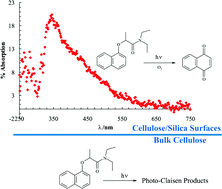Surface photochemistry of the herbicide napropamide. The role of the media and environmental factors in directing the fates of intermediates†
Abstract
The photochemical behaviour of the

* Corresponding authors
a
FCT, Universidade do Algarve, Campus de Gambelas, Faro, Portugal
E-mail:
jpsilva@ualg.pt
Fax: +351 289 800 066
Tel: +351 289 800 900, ext. 7644
b Centro de Química-Física Molecular, Instituto Superior Técnico, Lisboa, Portugal
c Department of Chemistry, Georgetown University, Washington, DC, USA
The photochemical behaviour of the

 Please wait while we load your content...
Something went wrong. Try again?
Please wait while we load your content...
Something went wrong. Try again?
J. P. Da Silva, E. V. Bastos, L. F. V. Ferreira and R. G. Weiss, Photochem. Photobiol. Sci., 2008, 7, 69 DOI: 10.1039/B713369C
To request permission to reproduce material from this article, please go to the Copyright Clearance Center request page.
If you are an author contributing to an RSC publication, you do not need to request permission provided correct acknowledgement is given.
If you are the author of this article, you do not need to request permission to reproduce figures and diagrams provided correct acknowledgement is given. If you want to reproduce the whole article in a third-party publication (excluding your thesis/dissertation for which permission is not required) please go to the Copyright Clearance Center request page.
Read more about how to correctly acknowledge RSC content.
 Fetching data from CrossRef.
Fetching data from CrossRef.
This may take some time to load.
Loading related content
